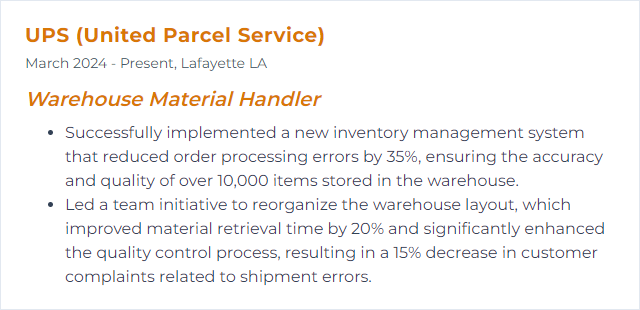Top 12 Warehouse Material Handler Skills to Put on Your Resume
In the fast-paced, often gritty world of logistics, a sharp skill set as a warehouse material handler can lift you above the pile. This article walks through the 12 core skills worth showcasing on your resume so hiring managers see readiness, not guesswork.
Warehouse Material Handler Skills
- Forklift Operation
- Inventory Management
- Pallet Jack
- RF Scanners
- Order Picking
- Shipping Procedures
- Receiving Protocols
- Warehouse Management Systems (WMS)
- Safety Compliance
- Barcode Scanning
- Packaging Techniques
- Quality Control
1. Forklift Operation
Forklift operation means using powered industrial trucks to move, load, unload, and stack materials safely and efficiently inside the warehouse.
Why It's Important
It speeds up material flow, handles weight humans can’t, preserves product integrity, and keeps storage tight and tidy—without it, throughput sinks.
How to Improve Forklift Operation Skills
Safety first, always: Follow site rules, speed limits, horn use, seat belts, and clear sightlines. Keep loads low and stable.
OSHA-compliant training: Earn certification and refresh at least every three years or after incidents or equipment changes.
Daily inspections: Brakes, steering, forks, mast chains, hydraulics, tires, warning devices—log it before the shift.
Load handling: Know capacity, load center, and mast tilt. Don’t exceed rated limits or lift damaged pallets.
Route discipline: Mark aisles, one-way traffic where needed, mirrored blind corners, well-lit docks and racks.
Charging/fueling best practices: Ventilation for charging areas, battery watering procedures, proper PPE, spill kits.
Continuous coaching: Ride-alongs, short refresh huddles, and corrective feedback without delay.
Well-run forklift programs cut incidents and keep clocks—and pallets—moving.
How to Display Forklift Operation Skills on Your Resume
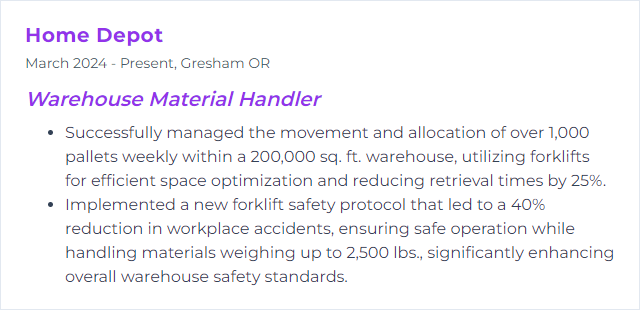
2. Inventory Management
Inventory management covers ordering, receiving, storing, tracking, and replenishing stock so the right items are available in the right quantities at the right time.
Why It's Important
Accuracy trims costs, avoids stockouts, stops overstock bloat, and keeps customers happy. Space opens up. Waste dries up.
How to Improve Inventory Management Skills
Use a system: Real-time tracking with barcodes or RFID, clear item masters, and accurate locations.
Cycle counts: Short, frequent counts beat giant annual surprises. Track accuracy and investigate variances.
ABC/velocity slotting: Keep fast movers close to packing; slow movers up high or farther out.
FIFO/FEFO: First-in-first-out or first-expiring-first-out to reduce obsolescence, especially on perishables.
Clean data: Standard units of measure, clear labeling, and tight receiving-to-putaway timing.
Dashboards that matter: Inventory accuracy, shrink, days on hand, and fill rate drive action.
Cross-team rhythm: Purchasing, operations, and shipping sync demand, lead times, and replenishment.
How to Display Inventory Management Skills on Your Resume
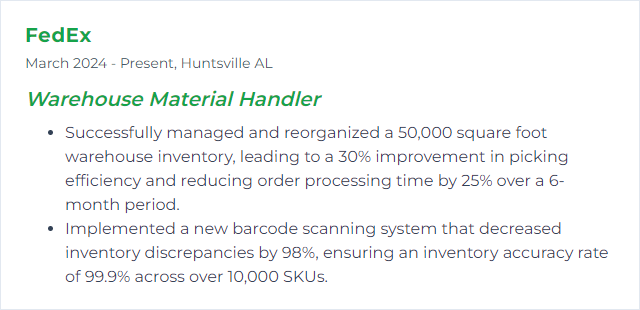
3. Pallet Jack
A pallet jack—manual or electric—lifts and moves palletized loads across the floor for short, frequent hauls.
Why It's Important
It’s quick, nimble, and easier on the body than muscling cases. Throughput rises without bringing a forklift to every task.
How to Improve Pallet Jack Skills
Training: Safe starts and stops, proper steering, two-hand control, clear foot placement, never ride the jack.
Pre-use checks: Wheels, forks, handle, hydraulics. Remove damaged gear from service immediately.
Load discipline: Center the weight, watch the load height, and avoid stacked instability.
Right tool: Use electric jacks for longer runs or ramps; manual for tight spots and light loads.
Floor care: Keep aisles clean, dry, and smooth—debris wrecks wheels and timing.
How to Display Pallet Jack Skills on Your Resume
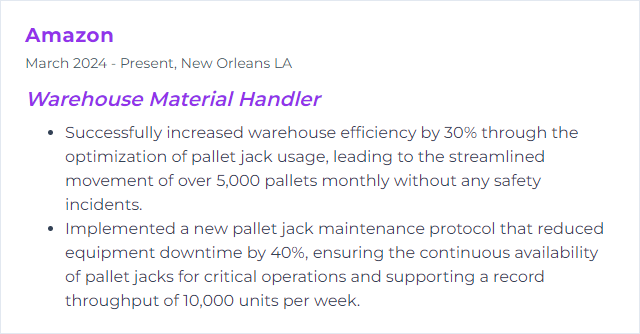
4. RF Scanners
RF scanners are handheld or wearable devices connected over wireless networks that capture barcodes (and sometimes RFID) to update inventory and task data in real time.
Why It's Important
Less typing, fewer errors, faster picks, instant visibility. Data moves with the work, not after it.
How to Improve RF Scanners Skills
Ergonomics: Choose light, balanced devices and comfortable grips or wearables to tame fatigue on long shifts.
2D imagers: Read damaged, tiny, or dense codes from more angles, faster.
Wi‑Fi performance: Strong coverage, smooth roaming between access points, and device caching for dead spots.
Smart workflows: Configure prompts, verify scans against tasks, reduce taps and screen hopping.
Battery discipline: Charged spares, rotation plans, and battery health tracking.
Device management: Standardized settings, security, and updates to keep fleets consistent.
Targeted training: Point-and-shoot basics, rescans, exception handling, and care of optics.
How to Display RF Scanners Skills on Your Resume
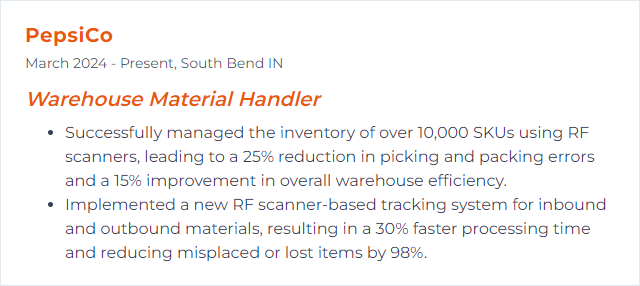
5. Order Picking
Order picking is the act of retrieving the right items, in the right quantities, to fulfill a customer order or internal demand.
Why It's Important
It touches speed, accuracy, and labor—three levers that decide customer happiness and cost per order.
How to Improve Order Picking Skills
Slot by velocity: Keep fast movers at ergonomic heights near pack-out. Shrink the footsteps.
Choose the right method: Single, batch, cluster, or zone picking—match approach to order profiles.
Guided technology: Use WMS-directed picks with scan validation. Voice or light cues reduce errors.
Better carts and totes: Dividers, scan holsters, and wheels that roll true. Small upgrades, big minutes saved.
Replenish on time: Trigger top-offs before bins run dry. Nothing kills flow like empty slots.
Quality checks: Weigh checks, photo checks, or audit scans at packing to catch misses early.
Chase the bottlenecks: Track lines picked per hour, distance walked, and error rates—then tweak layouts.
How to Display Order Picking Skills on Your Resume

6. Shipping Procedures
Shipping procedures cover packing, labeling, manifesting, staging, and handing off outbound freight while updating systems so orders can be tracked to the door.
Why It's Important
It’s the last touch before the customer sees the goods. Clean execution trims claims, delays, and cost.
How to Improve Shipping Procedures Skills
Standard packs: Right-size cartons, correct void fill, clear labels, and consistent sealing methods.
Scan to confirm: Validate items and quantities before sealing. Print labels after verification.
Cartonization logic: Use rules to pick the best carton and avoid air shipments—literally.
Cutoff discipline: Post carrier pickup times and stage by route. No last-minute scramble piles.
Dock scheduling: Smooth flow by time-slotting pickups and building lanes by carrier and service.
Damage prevention: Corner protection, banding when needed, and pallet overhang avoidance.
Documentation: Accurate manifests, BOLs, and tracking updates pushed promptly.
How to Display Shipping Procedures Skills on Your Resume
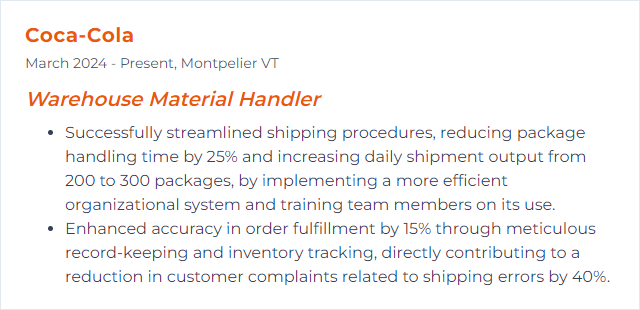
7. Receiving Protocols
Receiving protocols are the steps for unloading, inspecting, documenting, and putting away inbound goods so inventory starts accurate and stays that way.
Why It's Important
Bad receipts echo through the building: wrong counts, wrong locations, wrong orders. Tight intake silence the noise.
How to Improve Receiving Protocols Skills
Appointment and ASN use: Schedule docks and use advance shipment notices to plan labor and space.
Clear checks: Count, condition-check, and verify item IDs. Quarantine damaged or unknown goods.
Label at the door: Print scannable labels early and push guided putaway to the right slots.
Flow-first layout: Straight path from dock to staging to putaway, with room for mixed pallets.
PPE and ergonomics: Gloves, high-vis, dock plates, and lift assists to protect people and product.
Feedback to suppliers: Document recurring issues and close the loop so errors stop repeating.
How to Display Receiving Protocols Skills on Your Resume

8. Warehouse Management Systems (WMS)
A WMS is software that directs, records, and optimizes warehouse work—receiving, putaway, picking, packing, shipping, and counts.
Why It's Important
It cuts manual steps, boosts accuracy, and shines light on what’s happening right now, not yesterday.
How to Improve Warehouse Management Systems (WMS) Skills
Real-time everywhere: Scan-based moves, immediate updates, and exception prompts.
Automate the routine: Wave building, replenishment triggers, label printing, and cartonization rules.
Tailor screens: Role-based menus and minimal taps for handlers—speed over fluff.
Tight integrations: Clean handshakes with ERP, TMS, carriers, and automation equipment.
Analytics that drive action: Live dashboards for productivity, aging receipts, and backlog.
Train, then retrain: Short modules, on-the-floor coaching, and refreshers after updates.
How to Display Warehouse Management Systems (WMS) Skills on Your Resume
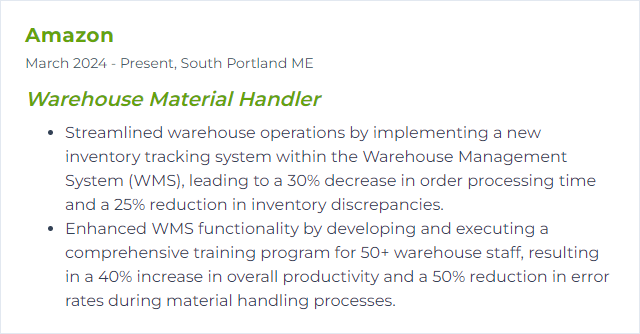
9. Safety Compliance
Safety compliance means following regulations and site rules to prevent injuries and property damage while handling materials and equipment.
Why It's Important
Safe teams stay productive. Fewer incidents, fewer costs, and a workplace people trust.
How to Improve Safety Compliance Skills
Training cadence: New-hire orientation, PIT certification where applicable, and frequent refreshers.
Spot the hazards: Regular walk-throughs for rack damage, blocked egress, spills, and pedestrian/forklift conflicts.
Ergonomics: Lift assists, team lifts, and job rotation to fend off strains and sprains.
PPE compliance: Correct gloves, eyewear, footwear, and high-visibility gear used and maintained.
Near-miss culture: Report, learn, improve—no blame, just fixes.
Clear signage: Speed limits, aisle widths, load limits, and emergency procedures posted and understood.
How to Display Safety Compliance Skills on Your Resume
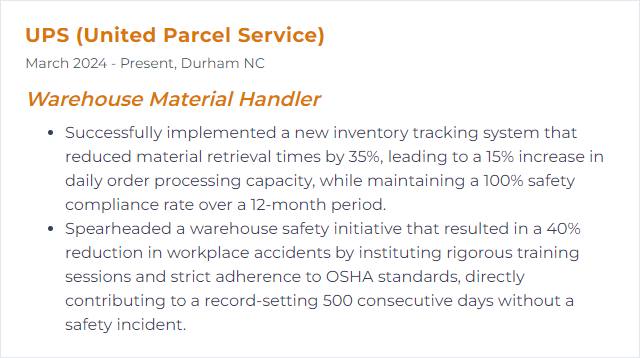
10. Barcode Scanning
Barcode scanning captures item, location, and order data with a quick read, feeding systems instantly to guide the next move.
Why It's Important
It is the backbone of speed and accuracy. Less typing, fewer mistakes, faster closes.
How to Improve Barcode Scanning Skills
Quality labels: High-contrast prints, durable stock for cold or dusty zones, and smart placement for easy reads.
Use robust symbologies: GS1-128, Code 128, or 2D codes (Data Matrix/QR) when you need more data in less space.
2D-capable devices: Faster reads from more angles, even on scuffed or curved surfaces.
Standards and verification: Set print specs and spot-check barcodes for grade and legibility.
Scan technique: Aim, steady, scan, confirm. Avoid glare, keep optics clean, and mind wrist posture.
Maintenance: Replace worn batteries, clean scan windows, and keep firmware current.
How to Display Barcode Scanning Skills on Your Resume

11. Packaging Techniques
Packaging techniques are the methods and materials used to protect goods, right-size shipments, label clearly, and keep items stable through transit.
Why It's Important
Strong packaging prevents damage, shrinks freight costs, and speeds pack-out. Clean, sturdy, simple.
How to Improve Packaging Techniques Skills
Right-size: Match carton to product and reduce void. Lighter, tighter, cheaper.
Protect properly: Use the correct void fill—paper, foam, air pillows—based on fragility and weight.
Palletize well: Brick or column stack as needed, add corner boards, and stretch-wrap with enough containment force.
Seal with intent: Tape width and pattern that holds. Wet tape for heavy or recycled cartons.
Label clarity: One visible label, flat and unobstructed. No barcode over seams.
Test and iterate: Use drop and vibration tests or follow recognized packaging test standards to validate designs.
How to Display Packaging Techniques Skills on Your Resume
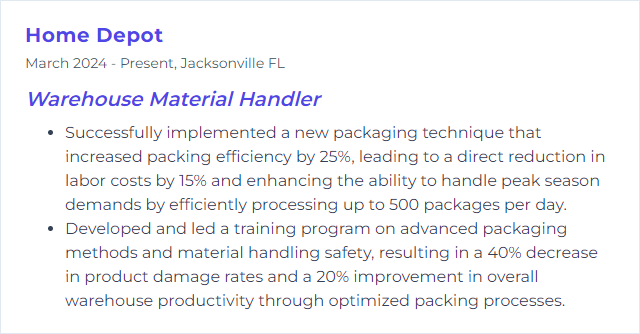
12. Quality Control
Quality Control ensures items received, stored, and shipped meet specified requirements—right product, right condition, right count.
Why It's Important
It prevents rework, returns, and customer frustration. Fewer defects; more trust.
How to Improve Quality Control Skills
Clear SOPs: Checklists for receiving, putaway, picking, packing, and shipping with measurable pass/fail points.
Sampling plans: Use risk-based inspections—more checks for high-value or fragile goods.
Visual standards: Photos of acceptable vs. defective product and packaging right at the station.
Calibrated tools: Scales, dimensioners, scanners, and torque/wrap settings checked on schedule.
Nonconformance tracking: Log issues, identify root causes, and implement corrective actions that stick.
Layered audits: Quick daily audits plus deeper weekly reviews to keep drift from creeping in.
How to Display Quality Control Skills on Your Resume
